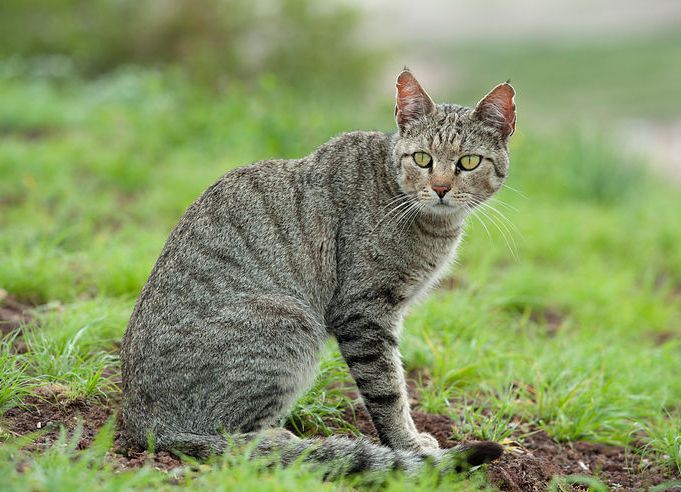
African wildcat(Felis lybica)
Phylum —chordata
Class — mammalia
Order — сarnivora
Family — felidae
Genus – felis
Appearance
The African wildcat's fur is light sandy grey, but almost whitish on the belly and on the throat. The ears have small tufts, are reddish to grey, with long light yellow hairs.The stripes around the face are dark ochre to black: two run horizontally on the cheek from the outer corner of the eye to the jaw, a smaller one from the inner corner of the eye to the rhinarium, and four to six across the throat. Two dark rings encircle the forelegs, and hind legs are striped. A dark stripe runs along the back, the flanks are lighter. Pale vertical stripes on the sides often dissolve into spots. Its tail has two to three rings towards the end with a black tip. Its feet are dark brown to black below.
It differs from the European wildcat by inconspicuous stripes on the nape and shoulders, a less sharply defined stripe across the spine and by the slender tail, less bushy and more tapering. Ears are normally tipped with a small tuft. Its fur is shorter than of the European wildcat.
Skins of male wildcats from Northern Africa measure 47–59.7 cm (18.5–23.5 in) in head-to-body length with a 26.7–36.8 cm (10.5–14.5 in) long tail. Skins of female wildcats measure 40.6–55.8 cm (16.0–22.0 in) with a 24.1–33.7 cm (9.5–13.3 in) long tail. Both females and males range in weight from 3.2–4.5 kg (7.1–9.9 lb).
Habitat
The African wildcat occurs across Africa, around the periphery of the Arabian Peninsula, and in the Middle East as far eastward as the Caspian Sea. It inhabits a broad variety of habitats, especially in hilly and mountainous landscapes. In deserts such as the Sahara, it occurs at much lower densities. It ranges across the area north of the Sahara from Morocco to Egypt and inhabits the tropical and subtropical grasslands, savannas, and shrublands south of the Sahara from Mauritania to the Horn of Africa, including Somalia, Eritrea, Ethiopia, Djibouti and Sudan. Farther south, it is present in all East and Southern African countries.
Behavior
African wildcats are active mainly by night and search for prey. Their hearing is so fine that they can locate prey precisely. They approach prey by patiently crawling forward and using vegetation to hide. They rarely drink water.They hunt primarily mice, rats, birds, reptiles, and insects.
In the daytime it usually hides in the bushes, although it is sometimes active on dark cloudy days.
Diet
In West Africa, the African wildcat preys on rats, mice, gerbils, hares, small to medium-sized birds, including francolins, and lizards. In Southern Africa, it also attacks antelope fawns and domestic stock, such as lambs.
In KgalagadiTransfrontier Park, it preys foremost on murids, also on birds, small reptiles.
Reproduction
Females give birth to one to three kittens, mostly during the warm wet season.
The gestation period lasts between 56 and 69 days. The kittens are born blind and need the full care of the mother. They stay with their mother for five to six months and are fertile after six months.
In captivity
African wildcat lifespan: 11 years in the wild and 19 years in captivity.
The best way to gain an animal`s respect is to hand-feed it since its childhood. So it will know that having you nearby is safe for it.
It is prohibited to play “fighting with an arm or a foot” with a kitten. It is better to use toys otherwise getting mature it will think that your own arms and feet are toys, it will bite and scratch them. It is recommended to play with a cat in the bathroom or in the swimming pool using “swimming” toys.
It is prohibited to shout at the cat or to beat it. For example, if it constantly climbs your dining table it should be punished by a spray or an air pump. You should say, ‘Don`t do it!” and blow hard. The cat will learn a lesson quickly and in the future a verbal command will be enough.
If a playing cat scratches or bites you, you should leave it alone. It will soon understand that it does something wrong if it is alone. These animals are very smart and require training as dogs do.
It is important all the family members to pay attention to the cat. You are its parents, its flock where it is safe and it is grateful for it.
It is necessary to teach a cat to use a toilet with a filler (desirably with a wood one). If it pooped in the wrong place you shouldn`t scold at it, you should give a verbal explanation and show the right place. Keep its toilet clean.
It is necessary to vaccinateAfrican wildcats as domestic cats. But you should be sure that the vaccination is of a good quality and does not contain active viruses. Otherwise your pet may fall ill and die. It is very important. Your pet can`t explain you what it hurts that`s why if you pay attention to its strange behavior and to the strange way it moves you must take it to the vet immediately.
Its diet consists of some raw meat with bones – poultry and beef (for example, chicken and quail thighs, wings, hearts, liver, cervixes). It`s preferably to add special vitamins with calcium supplements. Grownup cats eat from 0.3 up to 0.8 kilos of meat per day.
 Russian
Russian
 English
English


















